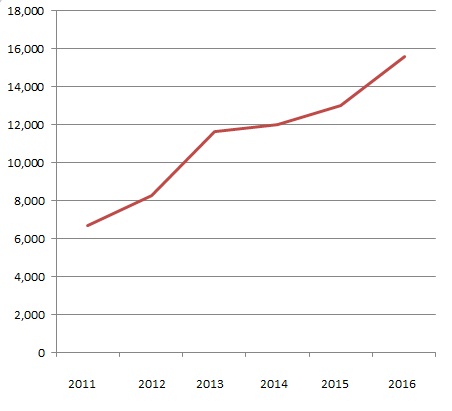But that traffic is not an efficient lead generation source. For HubSpot itself, according to its 2013 data when it was generating 60,000 leads a month, it took over 150 new inbound leads to produce one new customer. That’s actually better than for some companies using inbound.
When Jim Williams was Vice President of Marketing at Influitive he reported that only .25% of their new contacts became customers – just one in 400. He said, “These stats are actually quite common for high volume inbound funnels.”
Indeed they are. When I mentioned them to an analyst at a leading sales and marketing advisory firm he responded, “If not worse.”
To properly qualify and respond that kind of lead-to-deal ratio takes a lot of BDRs, software and money.
In a few cases, inbound can be much more efficient. If you have the rare situation of being in a nascent industry where (1) many people are searching for content with narrow search terms, and (2) you don’t have many competitors creating content, you can get high rankings and significant numbers of qualified inbound leads quickly. But that situation is rare.
Can HubSpot afford inbound? Can you?
So now let’s consider the original question in the title of this post: Can HubSpot afford to do inbound marketing anymore? And more importantly, can you?
HubSpot has access to the capital markets. It raised $100 million from VCs in six rounds over seven years to fuel its product development, marketing and sales. Then in 2014 it raised another $125 million with its IPO. It can afford to lose money as it builds its business. And it has. In over a decade it has never had a profitable quarter.
The more important question is: Can your company afford inbound marketing?
If you’re one of the 99% of startups who don’t receive venture funding, or have founders with very deep pockets, than you need to grow organically and — pretty quickly – profitably. Inbound isn’t usually going to produce results quickly and inexpensively enough.
The same is true for more mature SMBs, which is why I usually prescribe starting in the center of my Bullseye Marketing Framework instead.
Inbound really is for established companies that are generating profits and can wait a year or two or three for a significant impact.
And it depends on your competitive situation. If you’re in a market with lots of competitors who are pouring out tons of content, then the answer is: Probably not.
If you’re in an unusual industry like I described before, with many people searching for your offering and not much content competition, then inbound may be a good, long-term strategy for you.
What’s your competitive landscape look like? How much can your company afford to invest? How long can you wait for results?
What is your customer lifetime value relative to your customer acquisition cost? Is it profitable and sustainable?
No marketing strategy should be called a “movement”. Movements are for universal values. The Civil Right Movement was for equal rights for all people. The Women’s Movement was for all women having legal, economic and social parity with men.
But marketers should be guided by their particular situation, and the data, not by ideology. When inbound works, use it. When social media marketing works, use it. When account based marketing works, use it. When my Bullseye Marketing Framework works, use it.
And when they don’t, don’t. And switch to the strategies that will.
Update: A week after posting this, I received this tweet from a former VP of Sales at HubSpot:
 For decades physicists have searched for a unified field theory, because sub-atomic particles act so differently than the objects that we see in everyday life. It is a puzzlement.
For decades physicists have searched for a unified field theory, because sub-atomic particles act so differently than the objects that we see in everyday life. It is a puzzlement.








